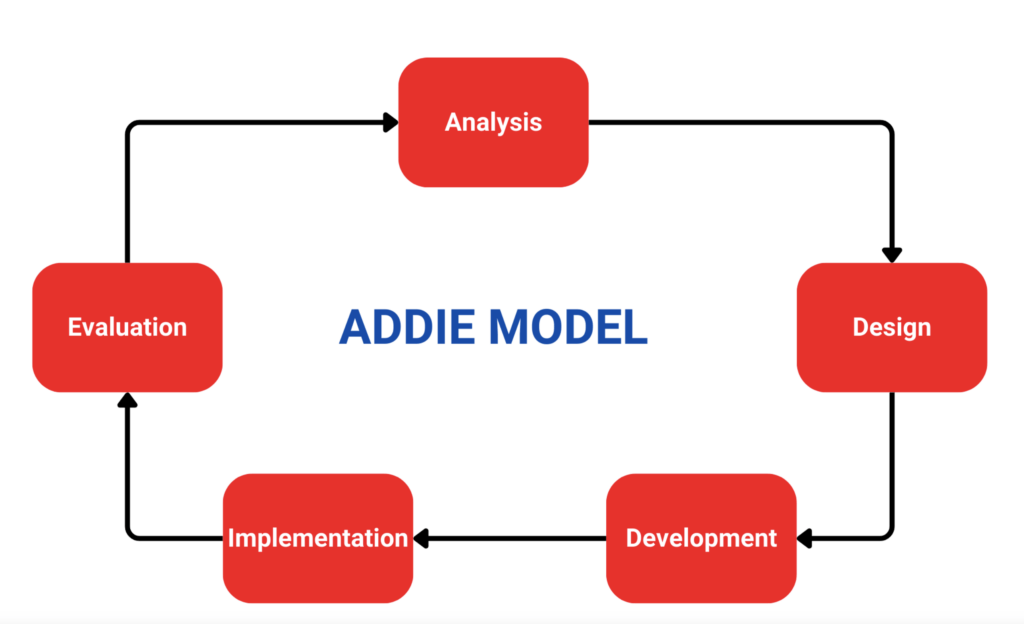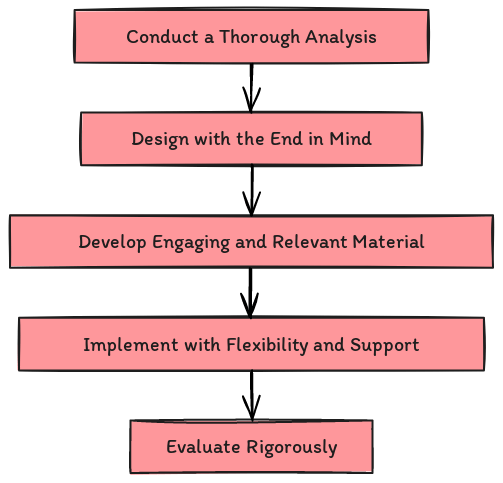Apprenticeship training programmes are key for nurturing talent and skills across various industries. The effectiveness of these programmes significantly hinges on their design and delivery methods. One powerful approach is the ADDIE model, a systematic instructional design framework. This article explores the ADDIE model, elucidating its relevance and application in apprenticeship training.

Understanding the ADDIE Model

ADDIE stands for Analysis, Design, Development, Implementation, and Evaluation. This model offers a structured and systematic training and educational programme development approach. Here’s a breakdown of each phase:
- Analysis: This initial phase involves understanding the apprentices’ needs, goals, and learning environment. It’s about identifying the skills gap and setting clear objectives.
- Design: This phase plans the structure and content of the apprenticeship programme. It outlines the curriculum, learning outcomes, and assessment methods.
- Development: This stage involves creating the training materials and resources. It’s where the theoretical designs become tangible educational tools.
- Implementation: In this phase, the apprenticeship programme is delivered. This includes teaching, mentoring, and applying the developed resources.
- Evaluation: The final phase involves assessing the effectiveness of the training. It looks at how well the objectives were met and what improvements can be made.
Why Use ADDIE in Apprenticeship Training?
The ADDIE model can be highly effective in apprenticeship training. Initially, it allows for thoroughly analysing learners’ needs and identifying specific skills and knowledge gaps. This targeted approach ensures that the training content is directly relevant to the apprentices’ career path and work environment. During the design and development phases, instructional strategies and materials are designed to meet these identified needs, allowing for a customised learning experience. Implementation involves delivering the training, which can be tailored to various learning styles, promoting a more inclusive and effective learning environment. Finally, the evaluation stage is essential as it provides feedback on the effectiveness of the training, highlighting areas for improvement. This continuous improvement cycle ensures that the training remains current and effective, directly contributing to the professional growth of apprentices and the overall success of the apprenticeship programme.
Key benefits include:
- Tailored Learning Experience: The ADDIE model ensures that the training is tailored to the apprentices’ needs, industry standards, and the organisation’s goals.
- Structured Approach: It provides a clear, step-by-step framework that enhances the quality and consistency of the training programme.
- Continuous Improvement: The evaluation phase allows for continual refinement of the training process, ensuring it remains relevant and effective.
Implementing ADDIE in Apprenticeship Programmes
- Conduct a Thorough Analysis: Engage with industry experts, trainers, and potential apprentices to understand the skills needed. Conduct surveys or interviews to gather detailed insights.
- Design with the End in Mind: Clearly define learning outcomes and align them with industry requirements. Plan interactive and engaging training sessions that cater to diverse learning styles.
- Develop Engaging and Relevant Material: Create informative and engaging materials. Use a mix of traditional and digital resources to cater to varied learning preferences.
- Implement with Flexibility and Support: Ensure trainers are well-equipped to deliver the programme. Incorporate feedback mechanisms to adjust the training as it progresses.
- Evaluate Rigorously: Use qualitative and quantitative methods to assess the programme’s effectiveness. Gather feedback from apprentices and trainers to identify areas for improvement.
Conclusion
The ADDIE model provides a comprehensive framework for designing and delivering effective apprenticeship training programmes. By adhering to its structured approach, training providers can ensure their programmes are educational, engaging, and aligned with industry needs. Implementing the ADDIE model can significantly contribute to developing skilled and competent professionals.



